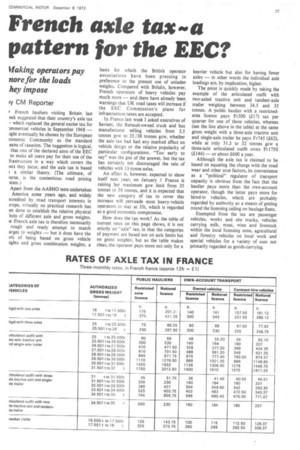French axle taxma pattern for the EEC?
Page 29

If you've noticed an error in this article please click here to report it so we can fix it.
Waking operators pay nore for the loads hey impose
)y CM Reporter
1, French hauliers visiting Britain last 'eek suggested that their country's axle tax which replaced the general excise tax for pmmercial vehicles in September 1968 iight eventually be chosen by the European conomic Community as the standard eans of taxation. The suggestion is logical, that one of the declared aims of the EEC to make all users pay for their use of the frastructure in a way which covers the ists they incur, and the axle tax is based
a similar theory. (The ultimate, of iurse, is the contentious road pricing stem.)
Apart from the AASHO tests undertaken America some years ago, and widely scredited by road transport interests in irope, virtually no practical research has en done to establish the relative physical 'ects of different axle and gross weights. le French axle tax is therefore necessarily rough and ready attempt to match arges to weights but it does have the !,rit of being based on gross vehicle tights and gross combination weights, a basis for which the British operator associations have been pressing in preference to the present use of unladen weights. Compared with Britain, however, French operators of heavy vehicles pay much more and there have already been warnings that UK road taxes will increase if the EEC Commission's plans for infrastructure taxes are accepted.
In France last week I asked executives of Saviem, the Renault-owned truck and bus manufacturer selling vehicles from 3.5 tonnes gvw to 35 /38 tonnes gcw, whether the axle tax had had any marked effect on vehicle design or the relative popularity of particular configurations. "Too early to say" was the gist of the answer, but the tax has certainly not discouraged the sale of vehicles with 13-tonne axles.
An effect is, however, expected to show itself next year; on January 1 France is raising her maximum gew limit from 35 tonnes to 38 tonnes, and it is expected that the new category of tax to cover this increase will persuade most heavy-vehicle operators to stay at 35t, which is regarded as a good economic compromise.
How does the tax work? As the table of current rates on this page shows, it is not strictly an "axle" tax, in that the categories of payment are based not on axle limits but on gross weights; but as the table makes clear, the operator pays more not only for a
heavier vehicle but also for having fewer axles in other words the individual axle loadings are, by implication, higher.
The point is quickly made by taking the example of the articulated outfit with two-wded tractive unit and tandem-axle trailer weighing between 34.5 and 35 tonnes. A public haulier with a restrictedarea licence pays Fr200 (£17) tax per quarter for one of these vehicles, whereas (see the line above in the table) at the same gross weight with a three-axle tractive unit and single-axle trailer he pays Fr745 (£62), while at only 31.5 to 32 tonnes gew a three-axle articulated outfit costs Fr1750 (£146)or about £600 a year.
Although the axle tax is claimed to be based on equating the charge with the road wear and other cost factors, its convenience as a "political" regulator of transport capacity is obvious from the fact that the haulier pays more than the own-account operator, though the latter pays more for hired-in vehicles, which are probably regarded by authority as a means of getting round the licensing ceiling on haulage fleets.
Exempted from the tax are passenger vehicles, works and site trucks, vehicles carrying milk, meat, wine and livestock within the local licensing zone, agricultural and forestry vehicles on local work and special vehicles for a variety of uses not primarily regarded as goods-carrying.








































































































